Comparison of Microstrip W-Band Detectors Based on Zero Bias Schottky-Diodes
Abstract
:1. Introduction
2. ZBD and Discrete Resistance Modeling
3. Detector Designs
3.1. Input Matching with Discrete Resistor (Version 1)
3.2. Input Microstrip Matching (Version 2)
3.3. Input Microstrip Matching (Version 3)
4. Experimental Measurements and Comparisons
Comparisons among the Three Different Versions of Detector Circuit
5. Conclusions
Author Contributions
Funding
Acknowledgments
Conflicts of Interest
Appendix A
References
- Biebl, E.M. RF Systems Based on Active Integrated Antennas. AEU-Int. J. Electron. Commun. 2003, 57, 173–180. [Google Scholar] [CrossRef]
- Shi, Y.; Jing, J.; Fan, Y.; Yang, L.; Li, Y.; Wang, M. A novel compact broadband rectenna for ambient RF energy harvesting. AEU-Int. J. Electron. Commun. 2018, 95, 264–270. [Google Scholar] [CrossRef]
- Janin, S.; Sripimanwat, K.; Phongcharoenpanich, C.H.; Krairiksh, M. A hybrid ring coupler quasi-optical antenna-mixer. AEU-Int. J. Electron. Commun. 2009, 63, 36–45. [Google Scholar] [CrossRef]
- Yaoa, C.H.; Chen, Z.; Gea, J.; Zhoub, M.; Weib, X. A compact 220 GHz heterodyne receiver module with planar Schottky diodes. AEU-Int. J. Electron. Commun. 2018, 84, 153–161. [Google Scholar] [CrossRef]
- Moyer, H.P.; Schulman, J.N.; Lynch, J.J.; Schaffner, J.H.; Sokolich, M.; Royter, Y.; Bowen, R.L.; McGuire, C.F.; Hu, M.; Schmitz, A. W-Band Sb-Diode Detector MMICs for Passive Millimeter Wave Imaging. IEEE Microw. Wirel. Compon. Lett. 2008, 18, 686–688. [Google Scholar] [CrossRef]
- Hrobak, K.M.; Sterns, M.; Schramm, M.; Stein, W.; Schmidt, L.P. Planar zero bias Schottky diode detector operating in the E- and W-band. In Proceedings of the European Microwave Conference, Nuremberg, Germany, 6–10 October 2013; pp. 179–182. [Google Scholar]
- Artal, E.; Aja, B.; De la Fuente, M.L.; Pascual, J.P.; Mediavilla, A.; Martinez-Gonzalez, E.; Pradell, L.; de Paco, P.; Bara, M.; Blanco, E.; et al. LFI 30 and 44 GHz receivers Back-End Modules. J. Instrum. 2009, 4, T12003. [Google Scholar] [CrossRef]
- Cano, J.L.; Aja, B.; Villa, E.; De la Fuente, L.; Artal, E. Broadband back-end module for radio-astronomy applications in the Ka-Band. In Proceedings of the 2008 38th European Microwave Conference, Amsterdam, The Netherlands, 27–31 October 2008; pp. 1113–1116. [Google Scholar]
- Gutiérrez, J.; Zeljami, K.; Villa, E.; Aja, B.; De la Fuente, M.L.; Sancho, S.; Pascual, J.P. Noise conversion of Schottky diodes in mm-wave detectors under different nonlinear regimes: Modeling and simulation versus measurement. Int. J. Microw. Wirel. Technol. 2016, 8, 479–493. [Google Scholar] [CrossRef]
- Xie, L.; Zhang, Y.; Fan, Y.; Xu, C.; Jiao, Y. A W-band Detector with High Tangential Signal Sensitivity and Voltage Sensitivity. In Proceedings of the 2010 International Conference on Microwave and Millimeter Wave Technology ICMMT Conference, Chengdu, China, 8–11 May 2010. [Google Scholar]
- Xu, K.; Zhang, Y.; Xie, L.; Fan, Y. A Broad W-band Detector Utilizing Zero-bias Direct Detection Circuitry. In Proceedings of the 2011 International Conference on Computational Problem-Solving (ICCP), 21–23 October 2011; pp. 190–194. [Google Scholar]
- Yao, C.; Zhou, M.; Luo, Y.; Xu, C. Millimeter wave broadband high sensitivity detectors with zero-bias Schottky diodes. J. Semicond. 2015, 36, 065002. [Google Scholar] [CrossRef]
- Tekbaş, M.; Erdoğan, M.S.; Ünal, İ. A W band waveguide detector module using zero bias schottky diode. In Proceedings of the IEEE 37th International Conference on Electronics and Nanotechnology (ELNANO), Kiev, Ukraine, 18–20 April 2017; pp. 137–142. [Google Scholar]
- Hoefle, M.; Penirschke, A.; Cojocari, O.; Jakoby, R. Broadband zero-bias Schottky detector for E-field measurements up to 100 GHz and beyond. In Proceedings of the 38th International Conference on Infrared, Millimeter, and Terahertz Waves (IRMMW-THz), Mainz, Germany, 1–6 September 2013; pp. 1–2. [Google Scholar] [CrossRef]
- Zhang, W.; Yang, F.; Wang, Z.X. W-band (90GHz) zero bias Schottky diode directive detector. In Proceedings of the Asia-Pacific Microwave Conference (APMC), Nanjing, China, 6–9 December 2015; pp. 1–3. [Google Scholar]
- Hesler, J.; Crowe, T.W. NEP and responsivity of THz zero-bias Schottky diode detectors. In Proceedings of the Joint 32nd International Conference on Infrared and Millimeter Waves, 2007 and the 2007 15th International Conference on Terahertz Electronics, IRMMW-THz, Cardiff, UK, 2–9 September 2007. [Google Scholar]
- Hrobak, M. Critical mm-Wave Components for Synthetic Automatic Test Systems; Springer: Berlin/Heidelberg, Germany, 2014. [Google Scholar]
- Tomkins, A.; Garcia, P.; Voinigescu, S.P. A Passive W-Band Imaging Receiver in 65-nm Bulk CMOS. IEEE J. Solid-State Circuits 2010, 45, 1981–1991. [Google Scholar] [CrossRef]
- May, J.W.; Rebeiz, G.M. Design and Characterization of W-Band SiGe RFICs for Passive Millimeter-Wave Imaging. IEEE Trans. Microw. Theory Tech. 2010, 58, 1420–1430. [Google Scholar] [CrossRef]
- Sánchez-Martín, H.; Sánchez-Martín, S.; Íñiguez-de-la-Torre, I.; Pérez, S.; Novoa, J.A.; Ducournau, G.; Grimbert, B.; Gaquière, C.; González, T.; Mateos, J. GaN nanodiode arrays with improved design for zero-bias sub-THz detection. Semicond. Sci. Technol. 2018, 33, 095016. [Google Scholar] [CrossRef]
- Han, R.; Zhang, Y.; Coquillat, D.; Videlier, H.; Knap, W.; Brown, E.; Kenneth, K.O. A 280-GHz Schottky Diode Detector in 130-nm Digital CMOS. IEEE J. Solid-State Circuits 2011, 46, 2602–2612. [Google Scholar] [CrossRef]
- Dhillon, S.S.; Vitiello, M.S.; Linfield, E.H.; Davies, A.G.; Hoffmann, M.C.; Booske, J.; Paoloni, C.; Gensch, M.; Weightman, P.; Williams, G.P.; et al. The 2017 terahertz science and technology roadmap. J. Phys. D Appl. Phys. 2017, 50, 043001. [Google Scholar] [CrossRef]
- Sizov, F. Terahertz radiation detectors: The state-of-the-art. Semicond. Sci. Technol. 2018, 33, 123001. [Google Scholar] [CrossRef]
- Zeljami, K.; Gutierrez, J.; Pascual, J.P.; Fernandez, T.; Tazon, A.; Boussouis, M. Characterization and Modeling of Schottky Diodes Up to 110 GHz for Use in Both Flip-chip and Wire-Bonded Assembled Environments. Prog. Electromagn. Res. 2012, 131, 457–475. [Google Scholar] [CrossRef]
- Gutiérrez, J.; Zeljami, K.; Fernández, T.; Pascual, J.P.; Tazón, A. Accurately Modeling of Zero Biased Schottky-Diodes at Millimeter-Wave Frequencies. Electronics 2019, 8, 696. [Google Scholar] [CrossRef]
- High Frequency Resistors. Available online: http://www.resistor.com/phifreq_hf.htm (accessed on 7 October 2019).
- Tiuri, M.E. Radio Astronomy Receivers. IEEE Trans. Antennas Propag. 1964, 12, 930–938. [Google Scholar] [CrossRef]
- Paschotta, R. Encyclopedia of Laser Physics and Technology; Wiley-VCH: Berlin, Germany, 2008. [Google Scholar]
- Richards, P.L. Bolometers for infrared and millimeter waves. J. Appl. Phys. 1994, 76, 1. [Google Scholar] [CrossRef] [Green Version]
- Leclercq, S. Discussion about Noise Equivalent Power and its Use for Photon Noise Calculation. Available online: http://www.iram.fr/~leclercq/Reports/About_NEP_photon_noise.pdf (accessed on 30 October 2019).
- Mackowiak, V.; Peupelmann, J.; Ma, Y.; Gorges, A. NEP-Noise Equivalent Power. Thorlabs Documentation. Available online: https://www.thorlabs.com/images/TabImages/Noise_Equivalent_Power_White_Paper.pdf (accessed on 30 October 2019).

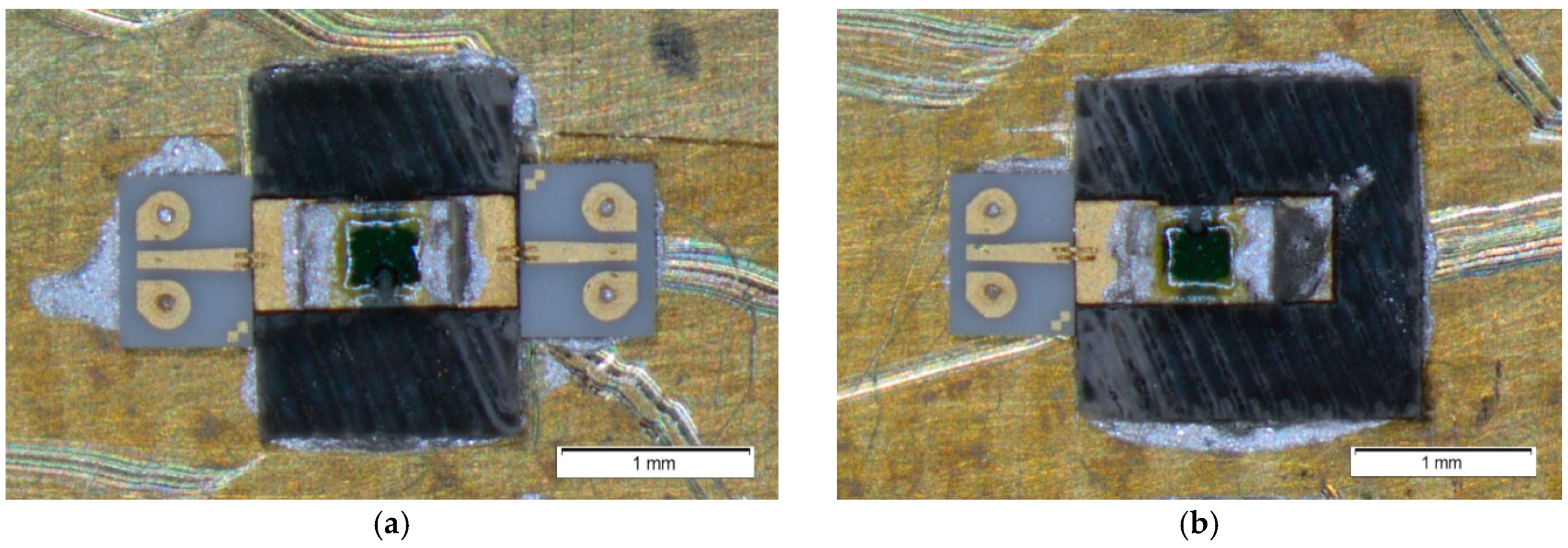
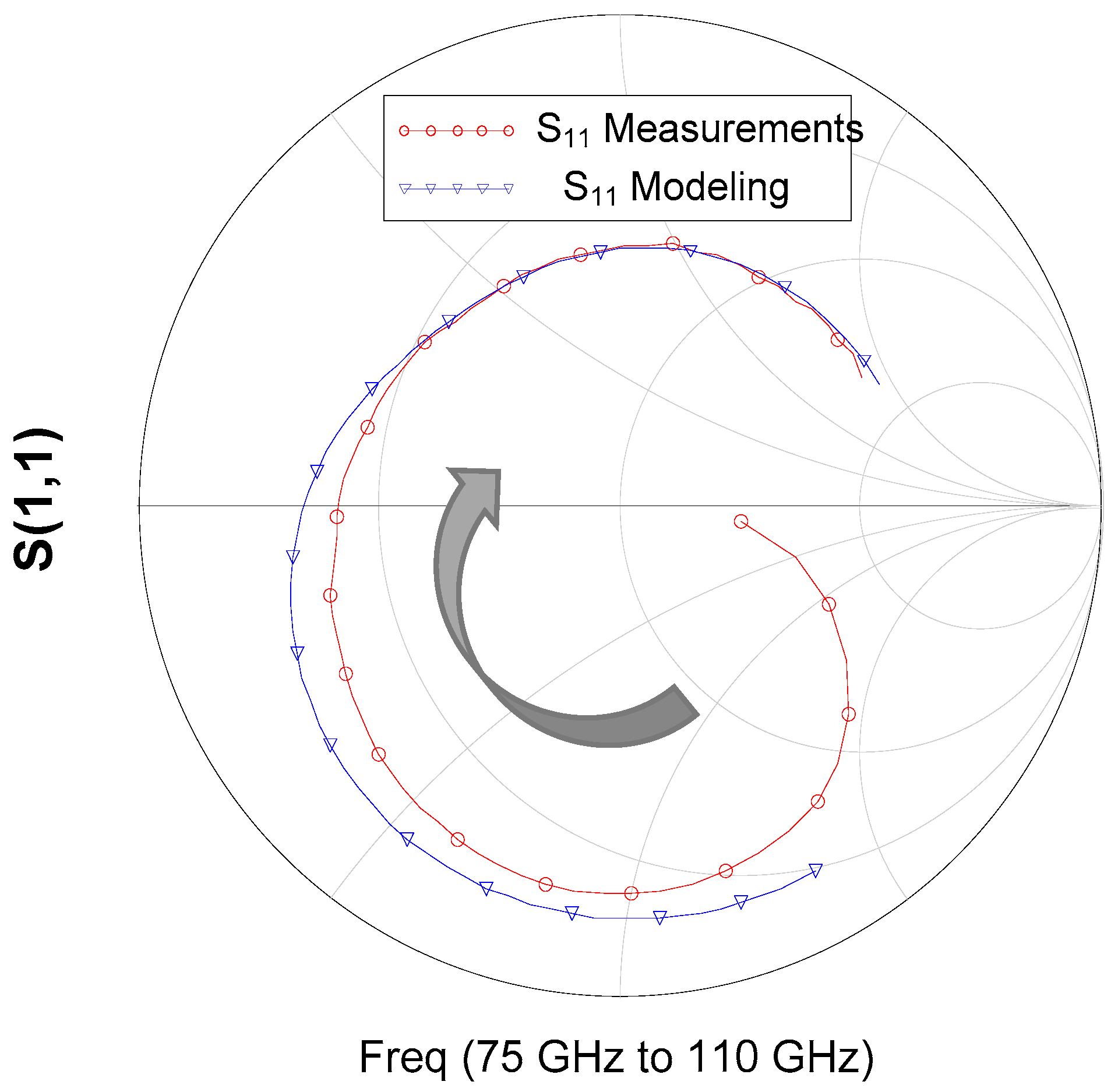
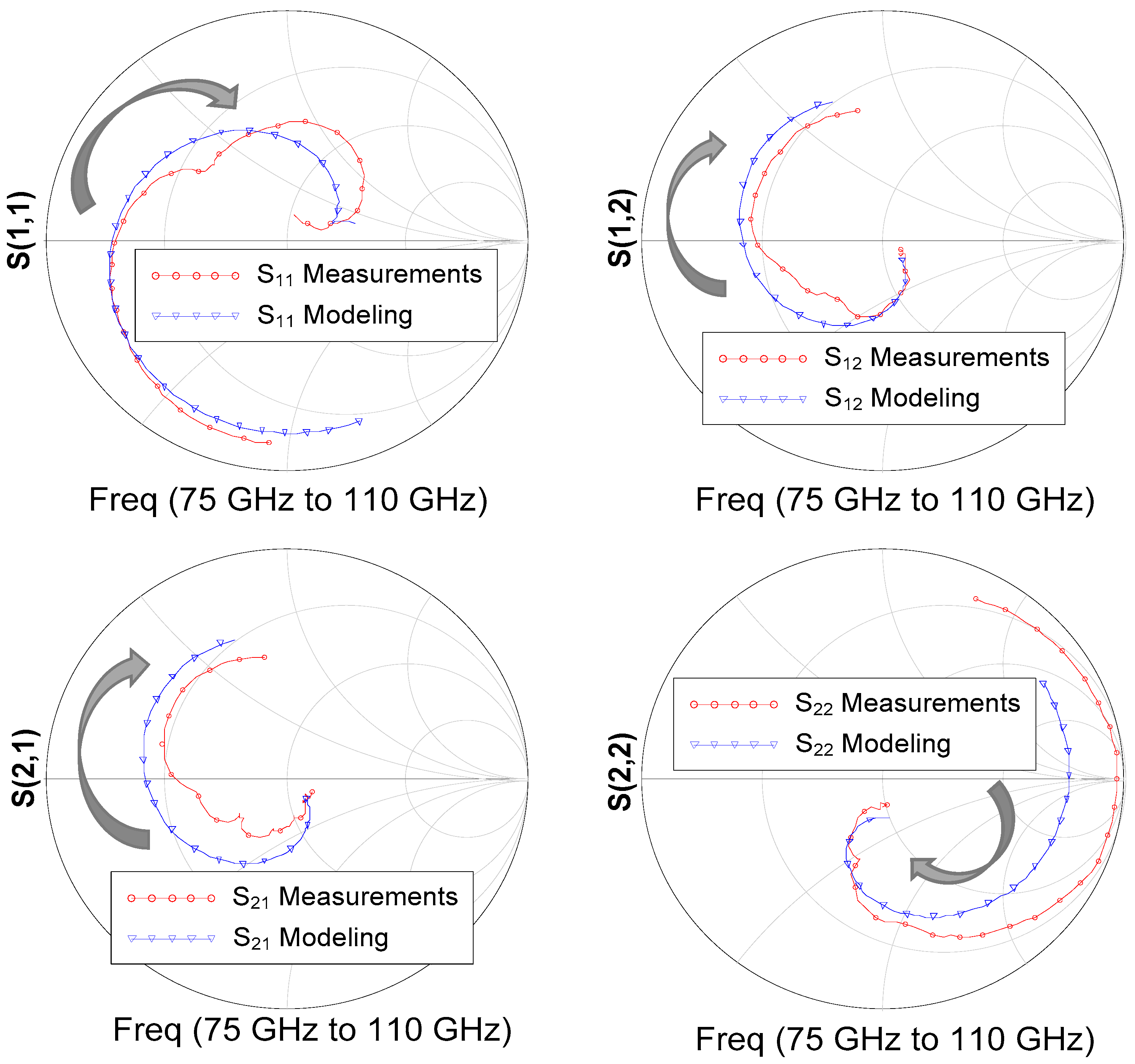

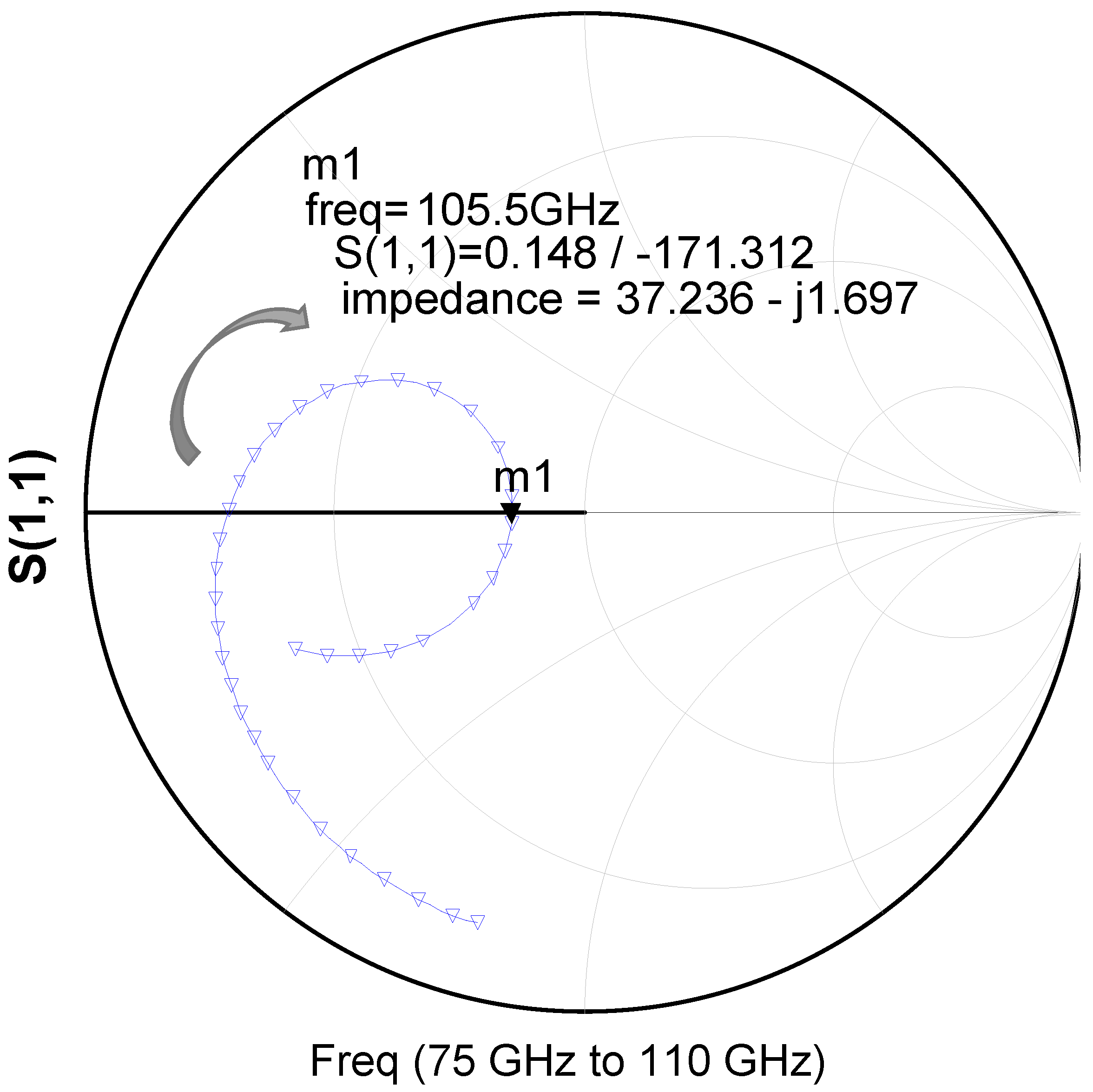

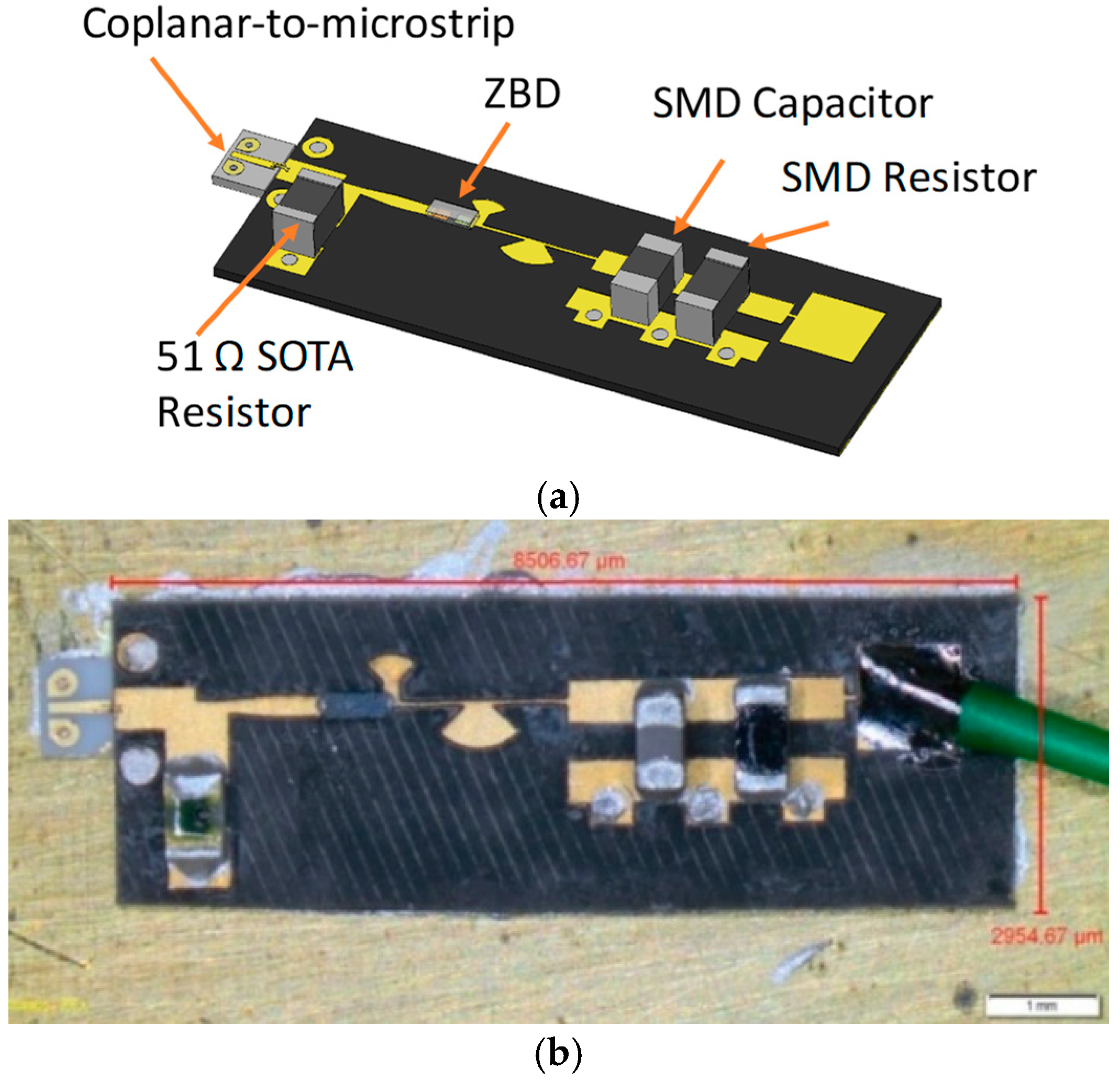
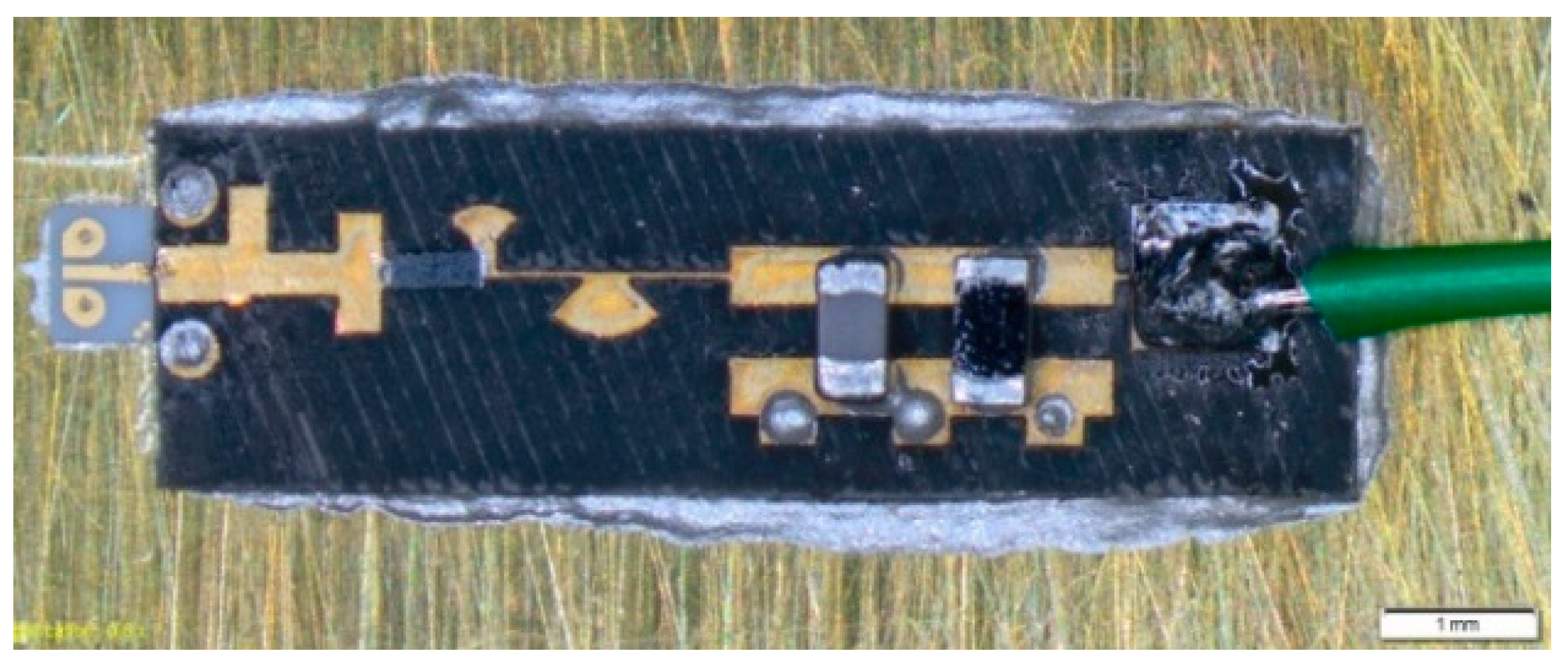



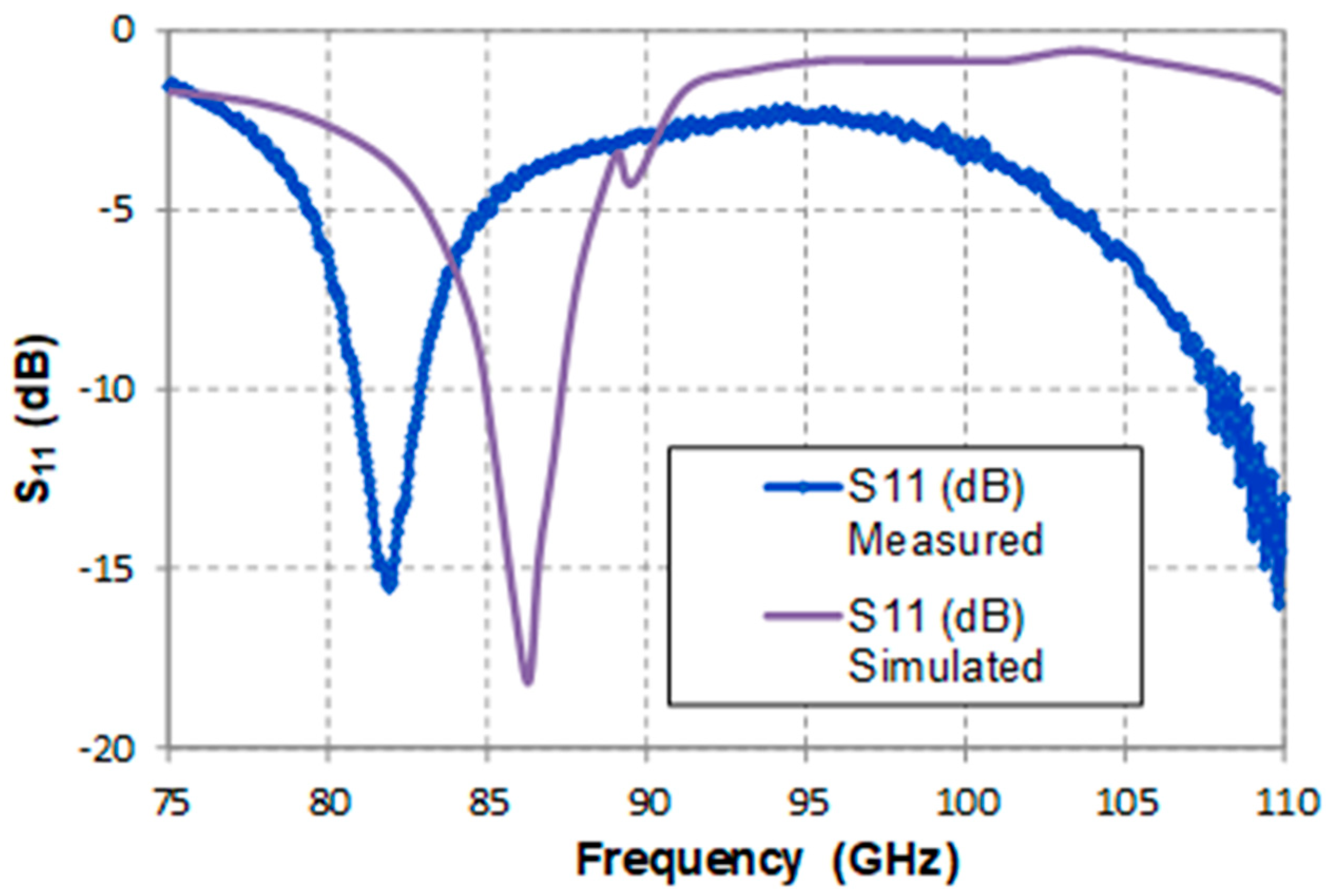

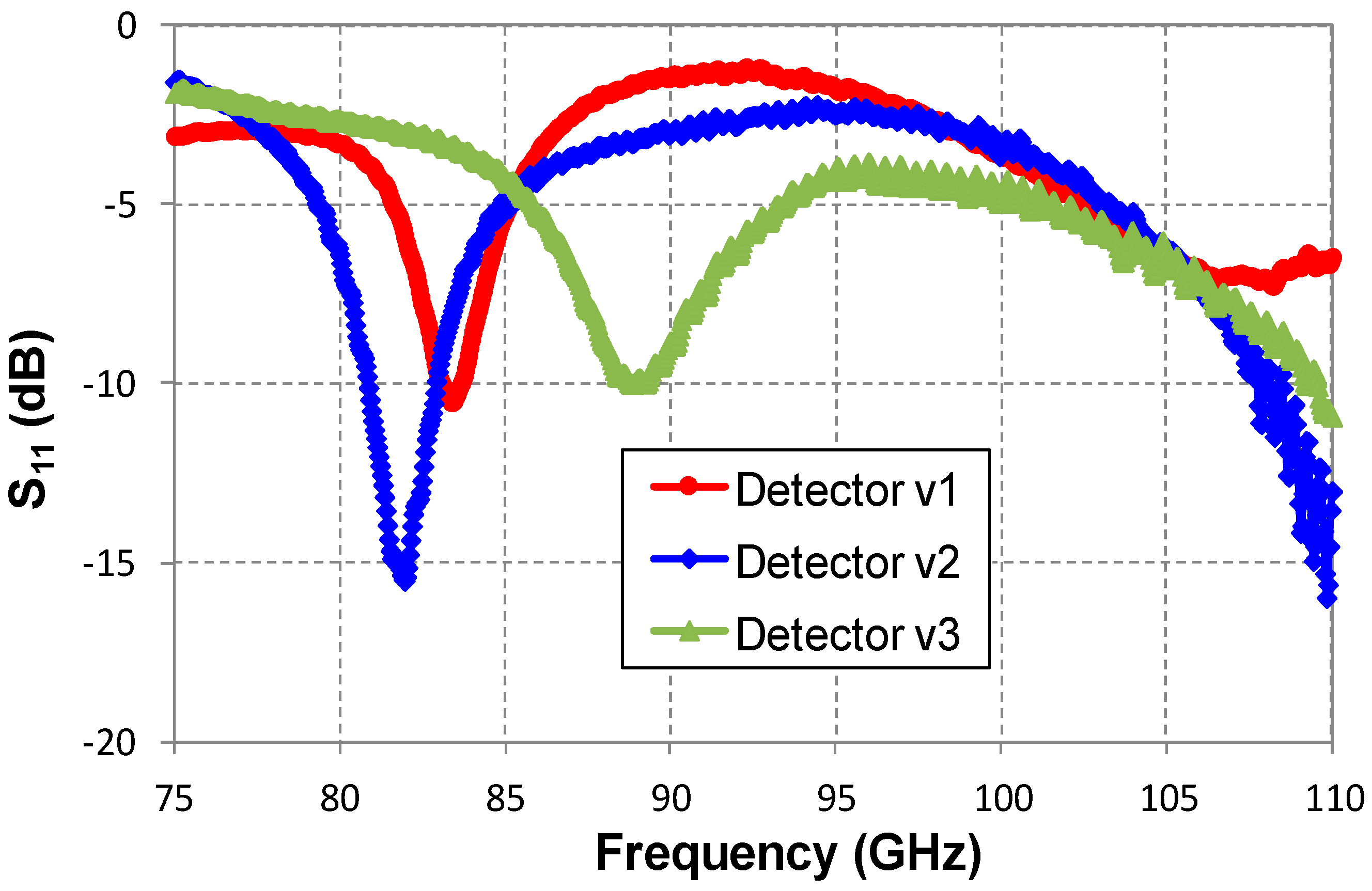
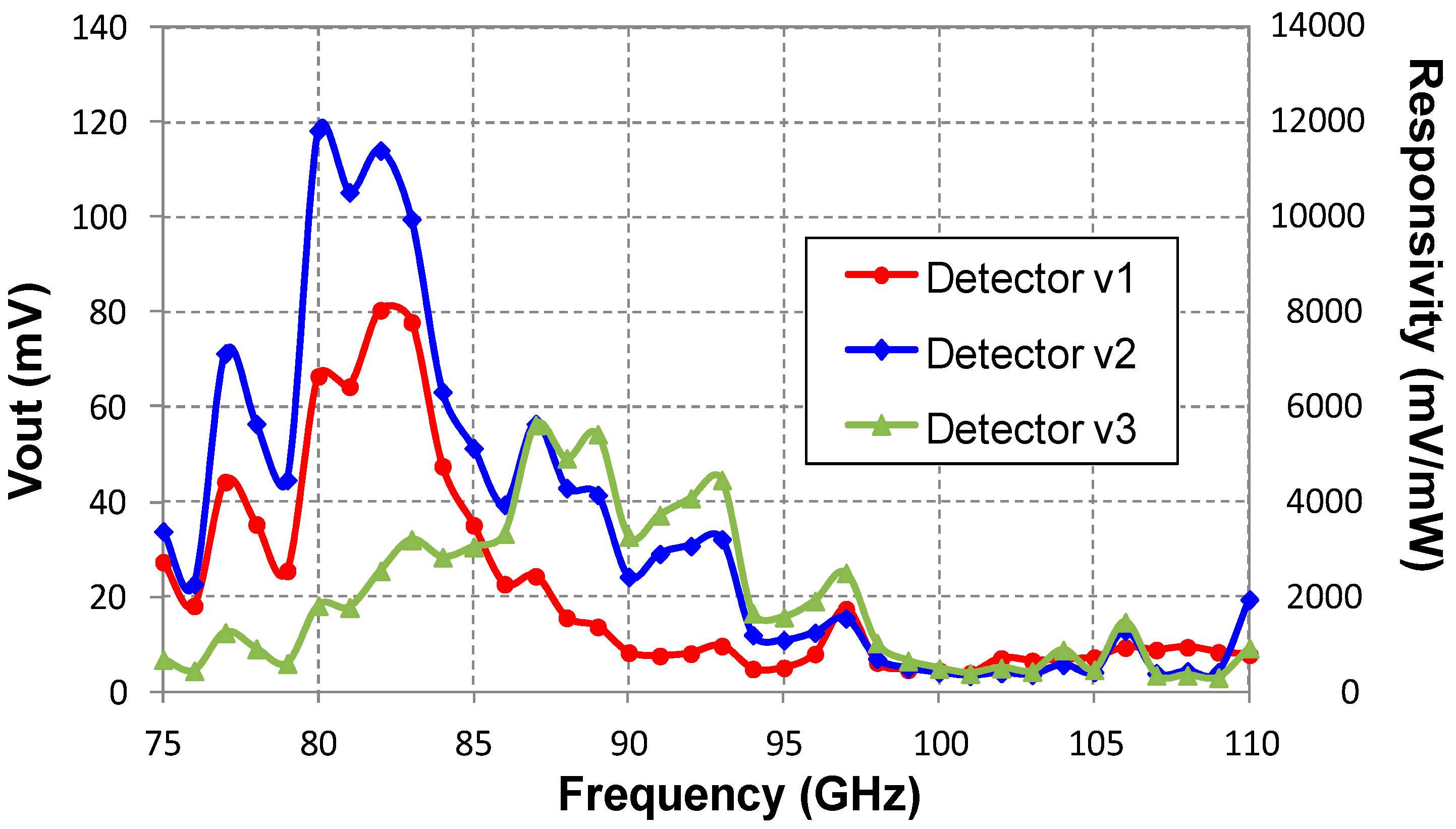
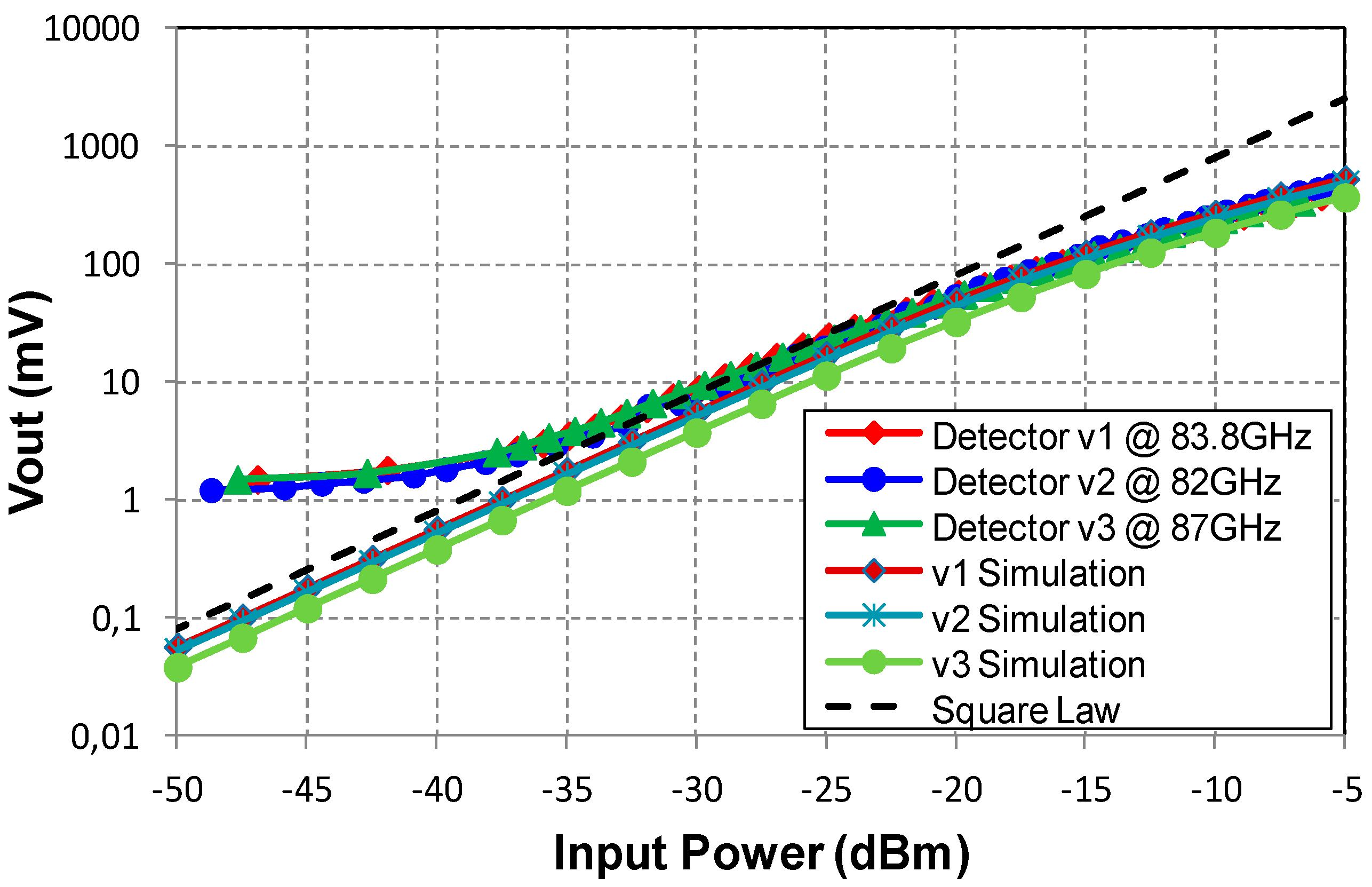
| Reference | Device | Responsivity (mV/mW) | TSS/NEP (dBm/pW/sqrt(Hz)) |
|---|---|---|---|
| [5] | Sb diode | 10,000 peak | |
| [6] | Schottky (VDI) | 6000 peak | −55/−45 |
| [10] | HSCH 9161 | 800–2200 | −49 |
| [11] | HSCH 9161 | 3800 peak | −49 |
| [12] | MZBD 9161 | 500 (11,800 peak) | −38 |
| [13] | MZBD 9161 | 700 (1000 peak) | |
| [15] | Schottky (VDI) | >2000 | −33 |
| [16] | Schottky (VDI) | 4000 | 1.5 |
| [18] | 65 nm CMOS | 80–200 | 200–400 |
| [19] | SiGe HBT | 12,000 | 2.5–4.5 |
| Parameter | Symbol | Value |
|---|---|---|
| Saturation Current (A) | Isat | 27.85 × 10−6 |
| Ideality Factor | η | 1.39 |
| q/ηkT (1/V) | α | 28.6 |
| Junction Capacitance (Vd = 0V) (fF) | Cj0 | 10 |
| Series Resistance (Ω) | RS | 6.5 |
| Junction Potential (V) | Vbi | 0.16 |
| Finger Inductance (pH) | Lf | 50 |
| Parasitic Capacitance (fF) | CP | 1 |
| Pad-to-Pad Capacitance (fF) | CPP | 16 |
| Input Inductance (pH) | LIN | 59.10 |
| Output Inductance (pH) | LOUT | 48.22 |
| Input Capacitance (fF) | CIN | 3.34 |
| Output Capacitance (fF) | COUT | 0.33 |
| Input Resistance (Ω) | RIN | 2.29 |
| Output Resistance (Ω) | ROUT | 2.34 |
| Coupling Capacitance (fF) | CCOUPLING | 18.37 |
| PAD IN Capacitance (fF) | CPAD1 | 39.17 |
| PAD OUT Capacitance (fF) | CPAD2 | 203.24 |
| Ground Capacitance (fF) | CGNDs | 10.97 |
| Detector Version | Responsivity (mV/mW) | BW Effective (GHz) | Pinmin (dBm) | NEP (pW/sqrt(Hz)) |
|---|---|---|---|---|
| Version 1 Resistor | 8000 (@83.5 GHz, −20 dBm) | 17.2 | −35 | 2.41 |
| Version 2. Microstrip Dual Stub | 11,000 (@82 GHz, −20 dBm) | 17.83 | −34.5 | 2.65 |
| Version 3 Microstrip Single Stub | 5000 (@87 GHz, −20 dBm) | 21.2 | −32.5 | 3.86 |
| Reference | Diode | Technology | Responsivity (mV/mW) | BWeff (GHz) | TSS/Pinmin (dBm) |
|---|---|---|---|---|---|
| [5] | Sb | MMIC | 10,000 (peak) | 44 | |
| [6] | Schottky (VDI) | MIC | 6000 (peak) | 60–110 | −55/−45 |
| [10] | HSCH 9161 | MIC | 800–2200 | −49 | |
| [11] | HSCH 9161 | MIC | 3800 peak | −49 | |
| [12] | MZBD 9161 | MIC | >500 (peak 11,800) 75–110 GHz >2000 * 80–104 GHz | 24 * (80–104) | −38 |
| [13] | MZBD 9161 | MIC Waveguide | ~700 (peak 1000) 75–110 GHz | ||
| [14] | Schottky (ACST) | MIC | 1–100 | ||
| [15] | Schottky (VDI) | MIC | >2000 86–94 GHz | 86–94 | −33 |
| [16] | Schottky (VDI) | 4000 | |||
| [18] | 65nm CMOS | MMIC | 80–200 | ||
| [19] | SiGe HBT | MMIC | 12,000 | ||
| This work Version 1, Resistor | Schottky ZBD (VDI) | MIC | 8000 (@83.5 GHz −20 dBm) | 17.2 | −35 |
| This work Version 2, Microstrip Dual Stub | Schottky ZBD (VDI) | MIC | 11,000 (@82 GHz −20 dBm) | 17.83 | −34.5 |
| This work Version 3, Microstrip Single Stub | Schottky ZBD (VDI) | MIC | 5000 (@87 GHz −20 dBm) | 21.2 | −32.5 |
© 2019 by the authors. Licensee MDPI, Basel, Switzerland. This article is an open access article distributed under the terms and conditions of the Creative Commons Attribution (CC BY) license (http://creativecommons.org/licenses/by/4.0/).
Share and Cite
Gutiérrez, J.; Zeljami, K.; Pascual, J.P.; Fernández, T.; Tazón, A. Comparison of Microstrip W-Band Detectors Based on Zero Bias Schottky-Diodes. Electronics 2019, 8, 1450. https://doi.org/10.3390/electronics8121450
Gutiérrez J, Zeljami K, Pascual JP, Fernández T, Tazón A. Comparison of Microstrip W-Band Detectors Based on Zero Bias Schottky-Diodes. Electronics. 2019; 8(12):1450. https://doi.org/10.3390/electronics8121450
Chicago/Turabian StyleGutiérrez, Jéssica, Kaoutar Zeljami, Juan Pablo Pascual, Tomás Fernández, and Antonio Tazón. 2019. "Comparison of Microstrip W-Band Detectors Based on Zero Bias Schottky-Diodes" Electronics 8, no. 12: 1450. https://doi.org/10.3390/electronics8121450






